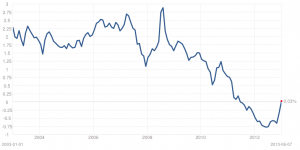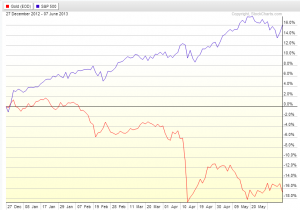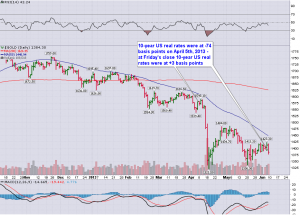2013 has been a challenging year for gold investors and the current macroeconomic environment appears to be highly unfavorable for the yellow metal - gold currently faces its most challenging fundamental backdrop in at least two decades:
- US 10-year real rates have risen 77 basis points in the last two months
- US 10-year real rates are positive for the first time since January 2012
Click to enlarge
- Inflation expectations remain muted as the US economic recovery continues apace
- The large gap between the performance of equities and gold during the past year has caused many investors to question gold’s place in an investment portfolio
Gold vs. S&P 500 year to date
- Perceived macro risk is arguably at its lowest level in more than five years despite the fact that there are many powder kegs simmering around the globe (eurozone, Syria, China/Japan, North Korea, etc.)
- One of the major underpinnings of the 2001-2011 gold bull market, the emerging markets & BRIC countries (Brazil, China, India, Lat Am, Russia), are experiencing a bumpy period as evidenced by recent equity market performances
- The market is seriously considering that we have reached the point of “peak Fed” and that we may begin sliding down the back side of “Fed Mountain” before the end of 2013
Why do real interest rates (nominal treasury yields minus inflation) matter to gold? Because as a cash alternative/cash substitute, the price of cash matters to the price of gold. If cash holders are being disincentivized to hold cash via negative real interest rates then they are much more likely to choose alternatives such as gold. Remember that market prices are made at the margin and the difference between -.20% and +.03% in terms of US 10-year real rates is quite significant. There is no doubt that if real interest rates continue to grow more positive it will weigh heavily on the gold price.
Have we reached “peak Fed”? Of course nobody knows for sure, but it is difficult to envision how the Fed will extricate itself and its $3.3 trillion balance sheet from global markets without leaving a large void and causing significant upset. It is quite possible that the Fed will taper back its LSAPs (large-scale asset purchases) before year end; however, I believe it is safe to say that the major global central banks (BOJ, ECB, Federal Reserve, PBOC) will be forever intimately involved in market functioning and that they will always err on the side of promoting inflation and backstopping asset prices.
Is there a bull case for gold or does the crowd have it right this time? Will inflation remain below the Fed’s inflation target for years to come? How long can the equity ‘nirvana’ environment of low inflation/peak corporate profit margins/tame macro backdrop/accommodative monetary policy continue?
The bull case for gold begins by scrolling back up to the list of bullet points and appreciating that all of these bullets are looking in the ‘rear view mirror’. We know what HAS happened, but it is what WILL happen in the future that matters most to investors. Remember that not much else scares central bankers more than the prospect of a protracted period of disinflation/deflation. The Bank of Japan, ECB, and Federal Reserve have all openly expressed a desire to achieve 2-2.5% inflation and thus far they are all falling short of this goal. Therefore, it would be unreasonable for markets to presume that inflation will remain at such low levels for an extended period.
The recent 5-year period of central bank balance sheet expansion has essentially managed to offset the pernicious deleveraging triggered by the global financial crisis. However, most of the excess liquidity has flowed to specific asset pockets with little impact upon price levels in the real economy. With global liquidity coffers brimming, it is now more likely than ever before that additional central bank balance sheet expansion will have a direct effect on price inflation in the real economy. Moreover, if global central banks find it difficult to achieve their stated inflation target levels they are much more likely to do more of what isn’t working (quantitative easing, negative deposit rates, etc.), rather than less.
Gold is a unique financial asset because it serves multiple roles; to some gold is a commodity, to others it is a currency alternative, yet to others it is an inflation hedge and insurance against major macro risks. This multi-faceted role has created numerous mixed signals and confusion among market participants in recent years. There is no doubt that gold’s $600 decline since its August 2011 peak is a result of some shine being taken off its hedge roles. The commodity aspects of gold pricing have taken over and it is no mistake that gold’s recent low at $1321/ounce is in line with current estimated marginal cost. If gold’s hedging and currency alternative roles are appreciated anew then price has no place to go but up.
While the rear view mirror of the past year certainly isn’t pretty for gold investors, gold is currently priced just above the marginal all-in cost of extraction and it is difficult to imagine that global central bankers will be able to continue perfectly ‘threading the needle’ going forward. Just as so many times in the past, being bullish on gold requires a variant view of future events, one that is much different than the rear view mirror of the recent past.
























